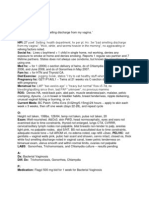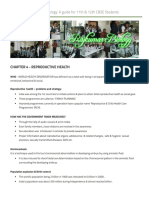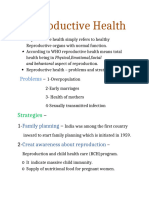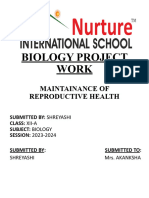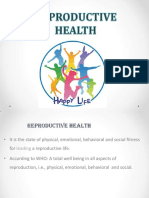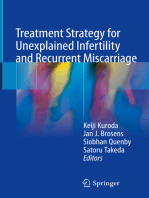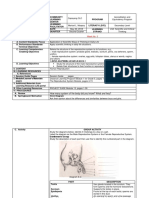0 ratings0% found this document useful (0 votes)
34 viewsRH Notes
RH Notes
Uploaded by
ajay11chandranBiology class 12 notes
Copyright:
© All Rights Reserved
Available Formats
Download as DOCX, PDF, TXT or read online from Scribd
RH Notes
RH Notes
Uploaded by
ajay11chandran0 ratings0% found this document useful (0 votes)
34 views5 pagesBiology class 12 notes
Original Title
RH notes
Copyright
© © All Rights Reserved
Available Formats
DOCX, PDF, TXT or read online from Scribd
Share this document
Did you find this document useful?
Is this content inappropriate?
Biology class 12 notes
Copyright:
© All Rights Reserved
Available Formats
Download as DOCX, PDF, TXT or read online from Scribd
Download as docx, pdf, or txt
0 ratings0% found this document useful (0 votes)
34 views5 pagesRH Notes
RH Notes
Uploaded by
ajay11chandranBiology class 12 notes
Copyright:
© All Rights Reserved
Available Formats
Download as DOCX, PDF, TXT or read online from Scribd
Download as docx, pdf, or txt
You are on page 1of 5
REPRODUCTIVE HEALTH
According to WHO, reproductive health means total well-being in all aspects
of reproduction i.e. physical, emotional, behavioral and social.
Reproductive Health: Problem and Strategies
India was amongst the first countries in the world to initiate to the
programme “family planning” initiated in 1951.
Reproductive health in a society forms a crucial part of general health.
Improved programs covering wider reproduction-related areas are
currently in operation under the popular name ‘Reproductive and child
health care (RCH) program.’
Health and education of young people and marriage and child bearing
during more mature stages of life are important attributes to the
reproductive health of a society.
Measures taken by Goverenment :
Through the help of audio-visuals & print media.
Even family members, close relations are involved in the awareness.
Sex education was introduced in schools to provide awareness
Proper information about reproductive organs, adolescence & related
changes , safe & hygienic sexual practices, sexually transmitted
diseases, AIDS etc.
Amniocentesis - It is a technique used to find out chromosomal
abnormalities in developing embryo by using amniotic fluid.
It is also misused to check foetal sex determination based on the
chromosomal pattern in the amniotic fluid surrounding the developing
embryo.
Population Explosion and Birth Control
Improved quality of life of people, increased health facilities and better living
condition had an explosive impact on explosion of population.
Rapid decline in death rate, MMR (maternal mortality rate) and IMR
(infant mortality rate) along with increase in population of reproductive
age is the main reason for population explosion.
Steps to overcome population explosion-
1. Using various contraceptive methods.
2. Educating people about the demerits of large family.
3. Increasing the marriageable age of female and male
4. Providing incentive to parents having 1or 2 children.
Contraceptive methods are used to prevent the unwanted pregnancy
and modifying the menstrual cycle.
An ideal contraceptive should be-
1. User friendly
2. Easily available
3. Effective
4. Reversible
5. No side effects
6. No way interferes with sexual desire and sexual act.
Contraceptive methods could be divided into following categories-
a) Natural or traditional methods
b) Barrier methods
c) IUDs
d) Oral contraceptive methods
e) Injectable
f) Implants
g) Surgical methods.
Natural methods works on the principle of avoiding chances of ovum
and sperm meeting. It includes-
a) Periodic abstinence- the couples avoid coitus from day 10 to 17 of
menstrual cycle as chances of fertilisation are very high during this
period, it is called the fertile period.
b) Withdrawal or coitus interruptus – male partner withdraws penis
from vagina just before ejaculation to avoid insemination .
c) Lactational Amenorrhea – absence of menstruation after parturition
and due to intense milk feeding and no ovulation in this period , chances
of fertilisation is nil.
In Barrier methods, ovum and sperms are prevented from physical
meeting with help of barrier. This includes-
a) Condoms- used by male, barrier made of rubber or latex sheet used
to cover penis or vagina and cervix of female. It also prevents from
STDs.
b) Diaphragms, cervical cap and vaults are barrier made of rubber
that is inserted into the female reproductive tract during coitus.
.Spermicidal creams, jellies and foams are usually used alongwith these
barriers to increase their contraceptive efficiency.
Advantages of barrier methods:
1. They are disposable.
2. They can be self –inserted.
3. They are reusable.
4. Prevents conception by blocking entry of sperm through cervix.
Intra uterine Devices- inserted by doctor or trained nurse into the
female uterus through vagina. IUCDs may be non-medicated IUDs (e.g.,
Lippes loop), copper releasing IUDs (CuT, Cu7, Multiload 375) and the
hormone releasing IUDs (Progestasert, LNG-20)
IUCDs increase the phagocytosis of sperm in uterus and copper reduce
the motility and fertility capacity of sperms .The hormone releasing IUDs
make the uterus unsuitable for implantation and the cervix hostile to the
sperms. It is ideal for female who wants to delay pregnancy and spacing
between two children.
Oral Pills are progesterone or progesterone-estrogen combination used
by females in form of tablets. They inhibit ovulation and implantation as
well as change the quality of cervical mucus to prevent/ retard entry of
sperms.Administration of progesterone or progesterone-estrogen
combination within 72 hours of coitus is found to be very effective as
emergency contraceptive.
Surgical method - This method is also called sterilisation.
It is used as terminal method of contraception in male and female to
prevent any more pregnancy.
Vasectomy is the surgical method in male; a small part of the vas
deferens is removed or tied up through a small incision on the
scrotum to prevent release of sperms.
Tubectomy is the surgical method in females in which small part of
fallopian tube is removed surgically.
These techniques are highly effective but their reversibility is very poor
Side effects of contraceptive method:
• It is very important that the selection of contraceptive method should be
taken under the consultation of the doctors.
• They have ill-effects like nausea, abdominal pain, breakthrough bleeding,
irregular menstrual bleeding or even breast cancer.
Medical Termination of Pregnancy
Voluntary termination of pregnancy before full term is called MTP (medical
termination of pregnancy) or induced abortion. It plays important role in
decreasing population by aborting unwanted pregnancy.
In India, MTP is legalized in 1971 with some restriction to prevent its
misuse such as indiscriminate and illegal female foeticides.
MTP is used to
Get rides of unwanted pregnancy due to unprotected intercourse or
failure of contraceptives used during coitus or rapes.
When pregnancy continuation could be harmful or even fetal to mother
or foetus.
MTPs are considered relatively safe during first trimester or up to 12
weeks of pregnancy. Second trimester MTPs are much more riskier.
Sexually Transmitted Disease (STDs)
Diseases or infections which are transmitted through sexual intercourse are
collectively called sexually transmitted disease or venereal disease (VD) or
reproductive tract infection (RTI).
Some common STDs are Gonorrhea, syphilis, genital herpes,
chlamydiasis, genital warts, trichomoniasis, hepatitis-Ba and AIDS.
Hepatitis-B and HIV is also transmitted by sharing of injection needles,
surgical instruments with infected person, transfusion of blood, or from
infected mother to foetus.
Except genital herpes, HIV and hepatitis-B are completely curable if
detected earlier and treated properly.
Timely detection and proper treatment of STDs are very important
otherwise it could lead to complications later, which include pelvic
inflammatory diseases (PID), abortions, still births, ectopic pregnancies,
infertility or even cancer of the reproductive tract.
Infections of STDs can be prevented by-
a) Avoid sex with unknown partners/multiple partners.
b) Always use condoms during coitus.
c) Go to a qualified doctor in case of doubt for early detection and get
complete treatment if diagnosed.
Infertility : The couples which are unable to reproduce children inspite of
unprotected sexual cohabitation are called infertile.The reasons for this could
be many-physical, congenital, diseases, drugs, Immunological or even
Psychological.
Infertile couples can be assisted to have children through certain special
techniques commonly called assisted reproductive technologies
(ART) ,which includes-
In vitro fertilisation (IVF)-fertilisation outside the body followed by embryo
transfer, which is commonly called test tube baby program. The ovum from
wife/donor and sperms from husband/ donor are collected and induced to
fertilize in laboratory conditions. The zygote or early embryo (8 blastomeres)
could be transferred into fallopian tube called ZIFT (zygote infra fallopian
transfer) and embryo with more than 8 blastomeres IUT (intra uterine transfer)
into the uterus to complete the further development.
GIFT (gamete intra fallopian transfer) –transfer of gametes collected from a
donor into fallopian tube of another female who do not produce ovum.
Intra cytoplasmic sperm injection (ICSI)-specialized procedure to form an
embryo in laboratory in which sperm is directly injected into ovum.
Artificial insemination- infertility cases in which male partner is unable to
produce healthy sperms are treated by this technique in which semen
collected from donor is artificially introduced into vagina or into uterus, IUI
( intra uterine insemination) of the female.
All these techniques require extremely high precision handling by specialized
professional and expensive instruments. . Therefore, their benefits are limited
to certain countries and people.
Emotional, religious and social factors also prevent the adoption of these
methods.
You might also like
- Obgyn Soap Note ExampleDocument2 pagesObgyn Soap Note ExampleBluerobins94% (33)
- Biology Investigatory Reproductive HealthDocument12 pagesBiology Investigatory Reproductive HealthVIKRAMVIKKYOFFICIAL84% (43)
- OB-Gyn Case Presentation - BicornuateDocument53 pagesOB-Gyn Case Presentation - BicornuateZari Novela100% (1)
- PBL Module 13 FinalDocument2 pagesPBL Module 13 FinalAhmad Ibrahim Khairi100% (1)
- Chapter 4 - Reproductive Health NotesDocument5 pagesChapter 4 - Reproductive Health NotesShagufta100% (1)
- REPRODUCTIVE HEALTHDocument5 pagesREPRODUCTIVE HEALTHtarunpanwar119No ratings yet
- Ch-3 Reproductive HealthDocument7 pagesCh-3 Reproductive Healtharyansharmaa080No ratings yet
- Notes 230615 181512 DeaDocument5 pagesNotes 230615 181512 DeaAadilNo ratings yet
- Notes Chap 04Document8 pagesNotes Chap 04umamahfarooq75No ratings yet
- Reproductive HealthDocument8 pagesReproductive HealthPriyaa MNo ratings yet
- Chapter - 4 Reproductive Health - WatermarkDocument19 pagesChapter - 4 Reproductive Health - Watermarkrajputzerox22No ratings yet
- Reproductive Health NotesDocument6 pagesReproductive Health NotesadelgenomicsbengaluruNo ratings yet
- 2nd puc chapter-3 reproductive healthDocument12 pages2nd puc chapter-3 reproductive healthjssent1978No ratings yet
- 4.REPRODUCTIVE HEALTHDocument24 pages4.REPRODUCTIVE HEALTHrevyblack720No ratings yet
- Chapter 4 - Rajkumar Biology_ a Guide for 11th & 12th CBSE StudentsDocument5 pagesChapter 4 - Rajkumar Biology_ a Guide for 11th & 12th CBSE Studentspandeysonam0916No ratings yet
- Chapter 3 Reproductive HealthDocument18 pagesChapter 3 Reproductive HealthRitikNo ratings yet
- 12 Biology - Reproductive HealthDocument4 pages12 Biology - Reproductive HealthTanya Mishra100% (1)
- Reproductive Health Class 12 Notes Biology MyCBSEguideDocument1 pageReproductive Health Class 12 Notes Biology MyCBSEguidehusainmew70No ratings yet
- Reproductive HealthDocument4 pagesReproductive HealthbicemaduraiNo ratings yet
- Reproductive HealthDocument16 pagesReproductive Healthsharmaanju1519No ratings yet
- Reproductive Health XiiDocument7 pagesReproductive Health Xiiindianequality86No ratings yet
- Reproductive HealthDocument5 pagesReproductive Healthpedonika.tanked1No ratings yet
- Biology Investigatory Reproductive HealthDocument12 pagesBiology Investigatory Reproductive HealthSubath Kumar100% (1)
- Class 12 Biology Notes Chapter - 3reproductive HealthDocument20 pagesClass 12 Biology Notes Chapter - 3reproductive HealthKavinNo ratings yet
- Reproductive HealthDocument16 pagesReproductive HealthShazia Khatoon100% (1)
- Rajat Biology ProjectDocument19 pagesRajat Biology Projectrc4435007No ratings yet
- biology investigatory projectDocument16 pagesbiology investigatory projectdixieescott517No ratings yet
- Reproductive Halth ProjectDocument15 pagesReproductive Halth Projectkksidhu2905No ratings yet
- Reproductive HealthDocument6 pagesReproductive HealthBiju MylachalNo ratings yet
- Health ReproDocument5 pagesHealth Reproniharika14981189111No ratings yet
- Concept Tutorial: Presented byDocument35 pagesConcept Tutorial: Presented byBhavna SinghNo ratings yet
- xii chapter 4-1Document5 pagesxii chapter 4-1goshsneha06No ratings yet
- Class 12 ch-3 Biology Reproductive Health NotesDocument5 pagesClass 12 ch-3 Biology Reproductive Health NotesMRF- THE GAMING GULFNo ratings yet
- Reproductive Health Class12thDocument4 pagesReproductive Health Class12thjyothiviswaaaNo ratings yet
- Reproductive HealthDocument7 pagesReproductive Healthmd2028418No ratings yet
- And Social: Reproductive HealthDocument13 pagesAnd Social: Reproductive HealthUtkarsh SinghNo ratings yet
- Ch-3 Reproductive healthDocument6 pagesCh-3 Reproductive healthNandhiNo ratings yet
- Reproductive HealthDocument22 pagesReproductive Healthadityakumar50067No ratings yet
- Reproductive HealthDocument30 pagesReproductive Healthnexgenofficial0001No ratings yet
- Reproductive Health PrintDocument15 pagesReproductive Health Printdanhaynes011No ratings yet
- Reproductive HealthDocument9 pagesReproductive HealthvidushivbpsNo ratings yet
- PDF Document 24Document8 pagesPDF Document 24Ayush KkNo ratings yet
- Reproductive Health NEETDocument5 pagesReproductive Health NEETsoumya8587757No ratings yet
- Bio Chapter 3Document5 pagesBio Chapter 3Nihal kalladathil bijuNo ratings yet
- Reproductive HealthDocument6 pagesReproductive Health24 Rashi Anand JangdeNo ratings yet
- Reproductive Health Biology (Hod Notes)Document19 pagesReproductive Health Biology (Hod Notes)ankitvlogger876No ratings yet
- Class 12 Biology ch-3 NotesDocument5 pagesClass 12 Biology ch-3 Noteslinguini209No ratings yet
- Reproductive Health (Edustudy Point) - UnlockedDocument6 pagesReproductive Health (Edustudy Point) - UnlockedSam ManochaNo ratings yet
- CH 4 Reproductive HealthDocument7 pagesCH 4 Reproductive HealthiedugeniusNo ratings yet
- Lawrence BioDocument19 pagesLawrence Biodelip1504No ratings yet
- Chapter-4 Reproductive HealthDocument7 pagesChapter-4 Reproductive HealthbpmbhamoraNo ratings yet
- Biology ProjectDocument9 pagesBiology ProjectNitesh JaiswalNo ratings yet
- XII - Zool Ch4 REPRODUCTIVE HEALTH Hsslive PDFDocument4 pagesXII - Zool Ch4 REPRODUCTIVE HEALTH Hsslive PDFPrituNo ratings yet
- Reproductive Health-Problems & StrategiesDocument11 pagesReproductive Health-Problems & StrategiesUtkarsh SinghNo ratings yet
- Shelly 29 KB (2 Files Merged)Document25 pagesShelly 29 KB (2 Files Merged)Abhay SinghNo ratings yet
- Reproductive Health WorksheetDocument12 pagesReproductive Health WorksheetTK Tamila100% (1)
- Reproductive HealthDocument12 pagesReproductive HealthharshitsharmasportsNo ratings yet
- Chapter 3 XIIDocument4 pagesChapter 3 XIIsuryanshujjwal7No ratings yet
- Reproductive Health McqsDocument19 pagesReproductive Health McqsM.Tharun KumarNo ratings yet
- Reproductivehealthppt 140331090032 Phpapp02Document25 pagesReproductivehealthppt 140331090032 Phpapp02Antarip Acharya100% (2)
- Army Public School Gopalpur: Class-Xii Science Subject - Biology Chapter-4 Reproductive Health NotesDocument5 pagesArmy Public School Gopalpur: Class-Xii Science Subject - Biology Chapter-4 Reproductive Health NotesAshok KumarNo ratings yet
- Reproductive Health 2Document51 pagesReproductive Health 2divyaasreekumar3No ratings yet
- Treatment Strategy for Unexplained Infertility and Recurrent MiscarriageFrom EverandTreatment Strategy for Unexplained Infertility and Recurrent MiscarriageKeiji KurodaNo ratings yet
- In Vitro Fertilisation: PPT Done by - O.VarshithaDocument5 pagesIn Vitro Fertilisation: PPT Done by - O.VarshithaVarshitha ReddyNo ratings yet
- Anatomy and Physiology of Female Reproductive SystemDocument4 pagesAnatomy and Physiology of Female Reproductive SystemIanne RanchezNo ratings yet
- Senam KegelDocument10 pagesSenam KegelRAHMANo ratings yet
- Total Laparoscopic HysterectomyDocument8 pagesTotal Laparoscopic HysterectomySamir CastilloNo ratings yet
- Barrier Methods of ContraceptionDocument18 pagesBarrier Methods of ContraceptionJann Ericka JaoNo ratings yet
- Newman - Goldfarb Protocols For Induced Lactation: Decision ToolDocument1 pageNewman - Goldfarb Protocols For Induced Lactation: Decision ToolFundacionNo ratings yet
- Reproductive SystemDocument89 pagesReproductive SystemIbrahim Mahmoud Ali100% (1)
- Preliminary Main CongressDocument10 pagesPreliminary Main CongressImelda HutagaolNo ratings yet
- LNS Walkthrough v0 3Document3 pagesLNS Walkthrough v0 3PersonManNo ratings yet
- Reproductive System DLLDocument6 pagesReproductive System DLLMaricel Maapoy100% (2)
- Reproductive Health: Presented byDocument22 pagesReproductive Health: Presented byJulie RodelasNo ratings yet
- Embryology and Congenital Anomalies of The Female Genital SystemDocument42 pagesEmbryology and Congenital Anomalies of The Female Genital Systemvrunda joshiNo ratings yet
- Female Reproductive System Part 1 - SPC MLS1 - Histo LecDocument9 pagesFemale Reproductive System Part 1 - SPC MLS1 - Histo LecCesmaine SanchezNo ratings yet
- Activity 1: Can You Justify Me?: Hormone Yes No ReasonDocument2 pagesActivity 1: Can You Justify Me?: Hormone Yes No ReasonMa Rijubelyn Macaranas CapinpinNo ratings yet
- 01 Disorders of Sexual DevelopmentDocument29 pages01 Disorders of Sexual DevelopmentAbeer Sarayra100% (1)
- Human Reproduction WorksheetDocument3 pagesHuman Reproduction WorksheetDEEBAN0% (1)
- Menstrual Disorders: A) Primary Dysmenorrhea. Primary Dysmenorrhea Is Cramping Pain Caused by Menstruation. TheDocument7 pagesMenstrual Disorders: A) Primary Dysmenorrhea. Primary Dysmenorrhea Is Cramping Pain Caused by Menstruation. Thelaiba.akhtarNo ratings yet
- The Evaluation of Abnormal Uterine BleedingDocument16 pagesThe Evaluation of Abnormal Uterine BleedingEstefania gonzalez torresNo ratings yet
- Menopause SeminarDocument8 pagesMenopause Seminarsuman guptaNo ratings yet
- DocxDocument12 pagesDocxJojo JacobNo ratings yet
- Ovarian CystDocument1 pageOvarian CystLoriene LopezNo ratings yet
- Science 2ND Grading Human Reproductive SystemDocument5 pagesScience 2ND Grading Human Reproductive SystemYouls TorNo ratings yet
- Female Reproductive SystemDocument17 pagesFemale Reproductive SystemYsthanamhire TolentinoNo ratings yet
- Profil Condyloma Acuminata 1Document6 pagesProfil Condyloma Acuminata 1yuliNo ratings yet
- Natural Family Planning 2Document3 pagesNatural Family Planning 2Raymond M KamundimuNo ratings yet
- Performance Task 1Document3 pagesPerformance Task 1Jellie May RomeroNo ratings yet
- Anatomy and Physiology: Patient P / Room No. 415 - 1Document3 pagesAnatomy and Physiology: Patient P / Room No. 415 - 1Julianne B. Dela Cruz100% (1)
